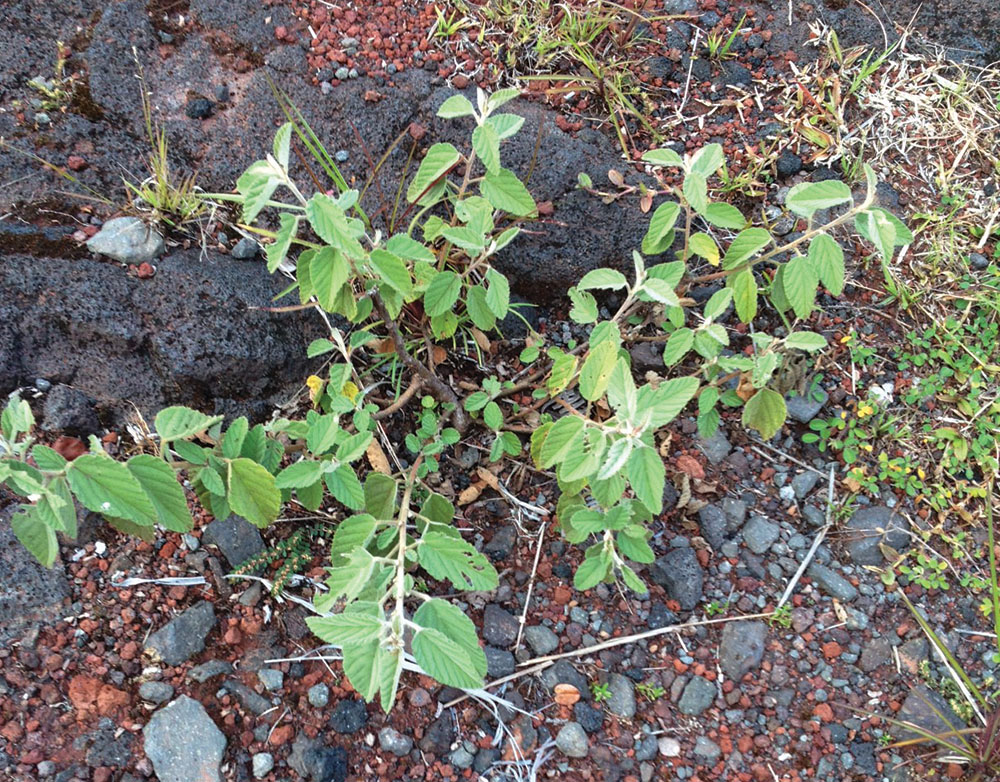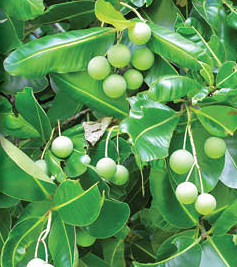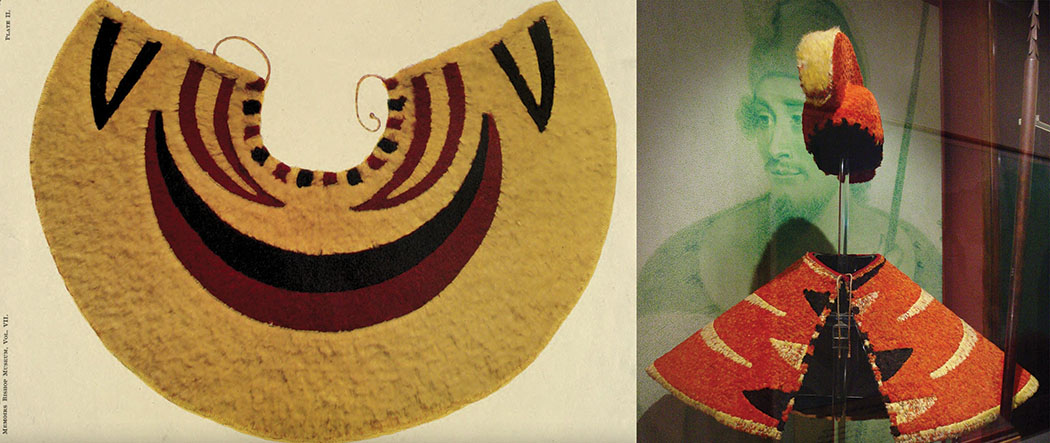
Healing Plants – ‘Uhaloa: Wonderful Weed is Useful for Many Ailments
 By Barbara Fahs
By Barbara Fahs
Residents in lower elevations on all Hawaiian Islands might have noticed a grey-green plant growing in seemingly impossible places on their properties. The plant is not especially attractive, so many people remove it from their carefully designed landscapes.
‘Uhaloa grows to only six feet tall under optimal conditions. It is sometimes called hi‘aloa in Hawaiian and Waltheria americana in the botanical world. Other nicknames include “sleepy morning,” “velvet leaf,” and “monkey bush.” Belonging to the same plant family as cacao (Sterculiaceae), this plant bears no similarity to the tree that produces chocolate.
Historical Uses in Hawai‘i
‘Uhaloa is believed to be an early Polynesian introduction, although concrete evidence of this is lacking. It has been used throughout Polynesia for hundreds of years for many different health concerns.
Early Hawaiian residents chewed the bark of its roots and swallowed the juice, in the belief that it helped to heal sore throats.
Practitioners pressed the juice from its roots, leaves, flowers and flower buds and gave it as a tea to individuals suffering from asthma.
Arthritic joints were helped when patients drank a tea brewed from the leaves.
Kumu Dane Silva of the Ohana Learning Institute writes, “‘Uhaloa may be used both internally and externally. Consuming it as a tea or oral rinse has both traditional and scientific support for self-care and prevention of inflammatory disorders. External use as a topical or transdermal application improves circulation in the inflamed extremities.”
Uses in Other Tropical Areas

‘Uhaloa is found in many other tropical parts of the world at the lower elevations. For example, in Africa, where a species known as Waltherica indica grows as a native plant, indigenous peoples have long made an extract from the plant, believing it useful for skin ailments as well as infections. Modern science has validated this use by determining that the plant contains astringent, tonic, analgesic, and emollient properties.
In Panama and other Central American regions, traditional practitioners make an eye wash from the leaves of this plant. In the same region, it is also used to treat some bronchial ailments.
‘Uhaloa and its related species are used for more than just medicine in some tropical areas. Its fiber is strong and has been utilized in the making of cords, sacking, padding, and sandals, according to a document from the US Forest Service. In Hawai‘i, canoe builders used pounded leaves to fill in cracks.
Growing ‘Uhaloa
If you live in a warm, dry area, you might have ‘uhaloa growing wild somewhere on your property. It thrives on neglect, preferring rocky areas and poor soil. It needs no water or fertilizer, since Mother Nature provides all of its needs. It can endure droughts, salt spray, and soil with higher than normal concentrations of salt. Even the bugs leave it alone.
Creating a garden area that includes Hawaiian native plants—whether they are medicinal or ornamental—helps to perpetuate some of our rare and endangered species. Although ‘uhaloa is not classified as endangered, it is uncommon in many parts of the world and is considered a native plant or early introduction.
To transplant ‘uhaloa, find a small, healthy plant on a friend’s property. Carefully dig it up and plant it in a sunny place in your yard. It reseeds itself readily, so be sure to leave space in your garden plan for more of these plants to pop up as volunteers.
If you harvest the small, round, dry fruit capsules, you can later plant the tiny seeds you find inside.
- Place the capsules in a brown paper bag and store them in a warm, dark, dry, well-ventilated spot for one week.
- Place the dried capsules into a strainer and rub them to force the seeds to separate and drop through onto a sheet of paper.
- Drop seeds onto a mixture of sterile potting soil and perlite or fine cinder. Cover with 1/8 inch of soil.
- Keep seeded flats in a shady area.
- Keep the soil moist until you notice seedlings germinating, which will occur in one to three months.
Contact writer Barbara Fahs: hiiakas@lava.net
Notes/Info/Sources
Earth Medicine Institute: EarthMedicineInstitute.com/more/library/medicinal-plants/waltheria-americana
University of Hawaii: Botany.hawaii.edu/faculty/carr/sterculi.htm
Tropilab Inc.: Tropilab.com/sleepy-waltheria.html
Native Plants Hawaii: Nativeplants.hawaii.edu/plant/view/Waltheria_indica
Hawaiian Native Plant Propagation Database: Hawaii.edu/~eherring/hawnprop/wal-indi.htm
US Forest Service document: Fs.fed.us/global/iitf/pdf/shrubsWaltheria%20indica.pdf


